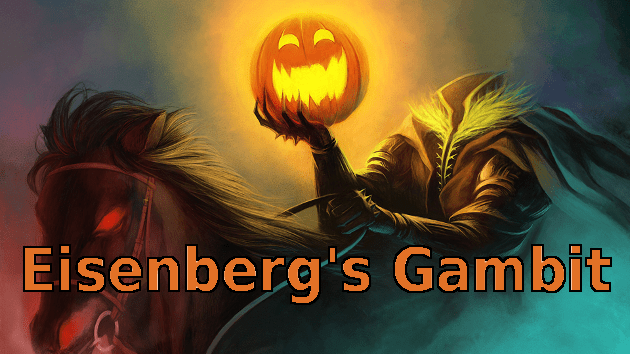
Eisenberg's Strange Gambit
One of the oddest, yet intriguing variations in the King's Gambit Accepted is one discovered by Louis Eisenberg.
Louis R. Eisenberg
On page 293 of "Emil Kemeny: A Life in Chess," John Hilbert quotes William Ewert Napier’s "Pittsburgh Dispatch" chess column of August 4,1904:
Mr. Eisenberg was born in Odessa in 1876 and after graduating from Nicholas College pursued journalisn until,
in 1902, he journeyed to Monte Carlo to participate in the international masters’ tournament played there under the auspices of the "Cercle des Étrangers." His victory on this occasion over Pillsbury, the American Champion, was his best effort. Coming from within a few hours ride of Kishinev, Mr. Eisenberg is naturally well informed on the subject of the recent disturbances there (the Kishinev Pogrom of 1903) and in this connection was interviewed in Chicago and his opinions given wide publicity. Like most of his countrymen of the educated class he is a splendid linguist, speaking seven languages. As Mr. Eisenberg is a full citizen of the United States he will be eligible to all national events, and we are much mistaken if affairs chessical do not enjoy a notable enlivenment so long as he remains in our midst.
The previous year Eisenberg had moved to Pittsburgh where Napier also lived. [Napier was born in England in 1881, moved to the US in 1886, then to Brooklyn in 1895. In 1900, he moved to Pittsburgh. He would become a US citizen until 1908] Again, according to Hilbert, this time in "Napier: The Forgotten Chessmaster," Eisenberg and Napier met for two games in 1903, both ending in draws. Or, as "Checkmate: Monthly Chess Review" put it in their Sept., 1903 issue: Eisenberg, a former Russian expert, is now a resident of Pittsburgh, Pa., where he is making it warm for Napier.
"The British Chess Magazine" of June, 1901 informs us of a suggestion of a new variation in the KG published in the "Schachmatny Journal" [A Russian periodical once edited by Schiffers] in February, 1901 by Louis R Eisenberg of Odessa.
Next "BCM" tells us: M. Eisenberg gives three moves in reply to this, which are the result of tests in the shape of club play in Odessa. He gives (a) 3...g5, (b) 3...d5, and 3...Qh4+
(a)
(b)
(c)
M. Eisenberg in recommending this new move either as given or in the Vienna Gambit variation, expresses the hope that it will be tested by chess players in actual play. He gives the following games, played in the Odessa Chess Club, in illustration of the opening:
In all the databases I consulted, I could find only one master level game employing this gambit. I wasn't surprised to see is was Tartakower. The result was a draw.
This opening seems to defy established chess axioms such as A Knight on the Rim in Dim, as well as gambiting a pawn for no real development, but it's hard to find a real refutation. Then again, possibly because of it's oddness and superficial dysfunctionality, it doesn't seem to have been analyzed properly to find the refutation.
Below is some amateur analysis by some chess.com members.
It seems the best line for Black and a good starting point is:
Alternate lines might go:
It would be interesting, in the absence of master games, to see any other ideas in seeing how or if this opening might be refuted. Feel free to post them here.



